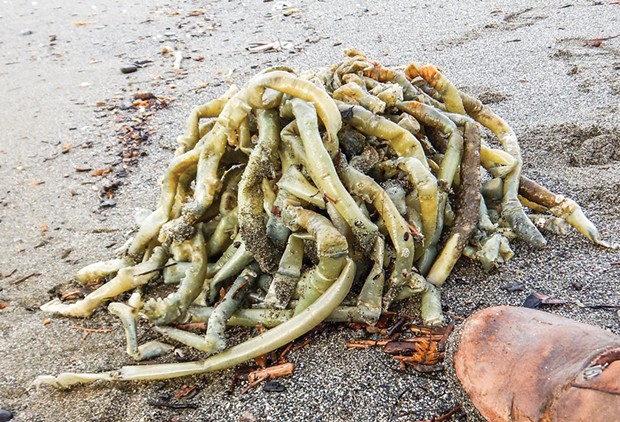[
{
"name": "Top Stories Video Pair",
"insertPoint": "7",
"component": "17087298",
"parentWrapperClass": "fdn-ads-inline-content-block",
"requiredCountToDisplay": "1"
}
]
Flydentifier: "What's going on guys? It's your pal Flydentifier with another livestream during which I'll fly around helping perplexed beachgoers identify washed-up things. I'm now hovering in front of our first customer."
Surfperch Angler: "What the hell ...?"
Flydentifier: "Ahoy, honorable surfperch angler! You have found a cluster of still-living parchment worms, which is a rare find. This worm's scientific name is Chaetopterus variopedatus. They occur in nearshore waters all over the world, though some scientists think there are actually several species. But either way, they make excellent surfperch bait. So, that's a great find for you, kind sir."
Surfperch Angler: "No shit."
Flydentifier: "Hey livestream subscribers, please donate any amount you can using the app in the chat. And don't forget to smash that 'like' button!"
Surfperch Angler: "Are you making money off me?"
Flydentifier: "Not yet, but my panoply of followers is super supportive. Now, parchment worms are a type of polychaete, or bristle worm. This species can be over a foot long and it lives in a tube constructed of a tough parchment-like material. Typically, the tube is U-shaped and buried with each end protruding from the substrate. Though in deeper areas it may be attached to bedrock and can form clusters like this one. The worm pumps water through the tube to filter it through a mucous net and catch food particles, which consist of small plankton and detritus. Isn't that fascinating, expert angler?"
Surfperch Angler: "I couldn't care less, asshole."
Flydentifier: "Parchment worms look unlike your typical worm. They have many segments like a lot of worms, but the segments are arranged into three distinct subsections. The head section bears a row of bristles on each side and a central longitudinal groove containing hairlike cilia that beat to move the food-laden mucous net toward the shovel-like mouth. This section also secretes the material used to make the tube. The second subsection is made up of four fatter segments. The first of these secretes the mucous food net, and the next three segments bear fan-like extensions that pump the water."
Surfperch Angler: "Take that!"
Flydentifier: "Whoa! He thrust his fishing pole at me like a fencer. See how I parried his thrust with one of my wings? En garde! Anyway, the third subsection of the worm is longer and made up of many segments bearing paired leg-like appendages. These appendages help the worm excavate its tunnel. It does all that work and then only lives for a year. Did you know that, my exalted outdoorsman?
Surfperch Angler: "No, but did you know you can kiss my ass?"
Flydentifier: "This species has other fascinating traits. It can eject a glowing blue or purple bioluminescent fluid that it presumably uses to confuse predators. The fluid is full of bacteria, which are what produce the luminescence. But oddly, the worm itself is blind so can't see its own glorious secretion. And if it is injured, it can produce an entire new individual worm from just a single segment. Additionally, other animals may live within the tube alongside the worm host. These include pea crabs that reside almost exclusively in Chaetopterus tubes. Please check to see if there's anyone else living in these tubes, noble sportsman."
Surfperch Angler: "No, but I'll do this!"
Flydentifier: "Whoa, he's casting hooks at me. Oh no, I'm snagged. Fly away! He's gaining line ... OUCH!"
Surfperch Angler: "Gotcha, you bastard! Gimme that phone. You viewers better donate some money to me, or else. Hey, you only have one viewer."
Chat: LOL. And I'm just here to see him get his ass kicked again.
Biologist Mike Kelly (he/him) is also the author of the book Tigerfish: Traditional and Sport Fishing on the Niger River, Mali, West Africa. It's available at Amazon or everywhere e-books are sold.
more from the author
-
Hot Tomcod Action
- Apr 18, 2024
-
Wandering Meatloaf
- Mar 7, 2024
-
Sea Palm Crime
- Jan 11, 2024
- More »
































